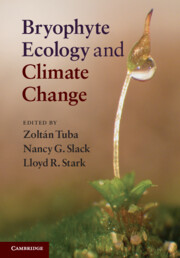Book contents
- Frontmatter
- Contents
- List of contributors
- Preface
- I Introductory Chapters
- II Ecophysiology
- III Aquatic Bryophytes
- IV Desert and Tropical Ecosystems
- V Alpine, Arctic, and Antarctic Ecosystems
- VI Sphagnum and Peatlands
- VII Changes in Bryophyte Distribution with Climate Change: Data and Models
- VIII Conclusions
- 23 Bryophytes as Predictors of Climate Change
- 24 Conclusions and Future Research
- Index
- References
24 - Conclusions and Future Research
Published online by Cambridge University Press: 05 October 2012
- Frontmatter
- Contents
- List of contributors
- Preface
- I Introductory Chapters
- II Ecophysiology
- III Aquatic Bryophytes
- IV Desert and Tropical Ecosystems
- V Alpine, Arctic, and Antarctic Ecosystems
- VI Sphagnum and Peatlands
- VII Changes in Bryophyte Distribution with Climate Change: Data and Models
- VIII Conclusions
- 23 Bryophytes as Predictors of Climate Change
- 24 Conclusions and Future Research
- Index
- References
Summary
Although it is difficult to draw general conclusions from such a variety of studies as those presented in this book, it is very obvious that there are already valuable data on bryophyte ecology in relation to many aspects of predicted climate change. There are baseline data from ongoing monitoring studies, as well as experimental research comparing bryophyte responses to ambient environmental factors, with responses to projected changes to those factors under various climate change models. In addition there are some reports of changes in bryophyte distribution (in relation to climatic factors) that have already occurred. In a concluding chapter, Gignac (Chapter 23, this volume) reviews much of the evidence of changing climate, indicates the advantage of utilizing bryophytes as indicators of such change, and provides an overview of bryological research relating to climate change. As Proctor notes in Chapter 3 of this volume, “the only certainty [with climate change] is change itself”, and “normal conditions” are an illusion. As he points out, determining the causes of bryophyte distributional changes in terms of concurrent climate data is fraught with cause/effect and correlational problems, leading scientists to be cautious in their evaluation of data in this field.
A great deal of recent research on bryophytes includes not only ecology and physiology but also the molecular aspects of bryophyte biology. The complete sequencing of the genome of the moss Physcomitrella patens is making newly possible the understanding of how special physiological traits of bryophytes are important to their ecology (Cuming 2009).
- Type
- Chapter
- Information
- Bryophyte Ecology and Climate Change , pp. 483 - 490Publisher: Cambridge University PressPrint publication year: 2011

